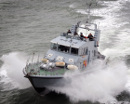Zanthra
Posts: 122
Joined: 2/6/2019
Status: offline

|
The seeking behavior also affects other missiles with datalinks. Including and probably not limited to, Harop, SLAMER, LRASM.
Also, it looks like if the weapon seeker is the only detection of a moving target, the impact point is one pulse of movement +- CEP. So for a car moving at 30 knots, that's 50 feet per second, and attacking with a tomahawk with 2m (about 6 foot) CEP will miss by 44 feet to 56 feet. If running in high fidelity mode at less than 15x speed, since the pulse length is 0.1 seconds that's reduced to 5 feet +- 6 feet, and is very likely to take out the target. If there is another source of detection for the target, it can hit mobile targets fine it seems.
If the target is never seen by the seeker, such as in heavy fog, the impact point is actually at the point the contact was last seen, even though the missile flies to the current location. It can damage units in the explosion that were near where the contact was lost, and far far from where the missile was when it explodes. When it says it missed by 70 nm, it means that the explosion was 70 nm from where the target currently is (and where the weapon was).
I figure the reason this does not show up all that much is due to the fact that there are not a lot of mobile units that tomahawks are used against (actually moving, there are many mobile SAM units that tomahawks are used against, but they rarely actually move). Add to that the fact that it needs to be out of recon for long enough that the missile does not see the target on it's seeker when it gets there.
PS: I discovered this seeking when using tomahawks to locate and identify mobile units in the Reds CoW bonus scenario as the resources for safe recon below cloud level and in close proximity to the USSR SAMs are limited. I was chasing a group of mobile units across the battlefield with tomahawks loitering around and occasionally clearing their course to get sensor updates. The PRC mobile units usually stay still, but they can shuffle to reorganize around a new group lead if the last one dies. If the new lead dies while the next in line is still shuffling into position, the group takes on the speed and direction of the new lead, and the group runs off in that direction.
< Message edited by Zanthra -- 3/10/2019 7:48:35 AM >
|
 Printable Version
Printable Version











 New Messages
New Messages No New Messages
No New Messages Hot Topic w/ New Messages
Hot Topic w/ New Messages Hot Topic w/o New Messages
Hot Topic w/o New Messages Locked w/ New Messages
Locked w/ New Messages Locked w/o New Messages
Locked w/o New Messages Post New Thread
Post New Thread